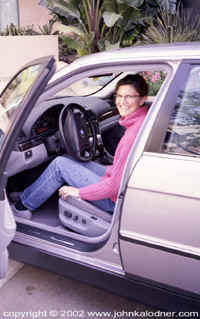


THE KEYS TO DEFENSIVE DRIVING
 |
 |
 |
Introduction
If you've been out on the roads, you know that not everyone drives well. Some people speed aggressively. Others wander into another lane because they aren't paying attention. Drivers may follow too closely, make sudden turns without signaling, or weave in and out of traffic.
Aggressive drivers are known road hazards, causing one third of all traffic crashes. But inattentive driving is becoming more of a problem as people "multi-task" by talking on the phone, eating, or even watching TV as they drive. We can't control the actions of other drivers. But learning defensive driving skills can help us avoid the dangers caused by other people's bad driving.
Skills That Put You in Control
Before you get behind the wheel of all that glass and steel, here are some tips to help you stay in control:
Stay focused. There are a lot of things to think about when driving: road conditions, your speed, observing traffic laws and signals, following directions, being aware of the cars around you, checking your mirrors - the list goes on. Staying focused on driving - and only driving - is key.
Distractions, like talking on the phone or eating, make a driver less able to see potential problems. It's not just teen drivers who are at fault: People who have been driving for a while can get overconfident in their driving knowledge and let their driving skills get sloppy. All drivers need to remind themselves to stay focused.
| The best strategy to deal with road rage is to get out of the driver's way as soon as it is safe to do so and keep a lot of distance between you. |
Stay alert. Being alert (not sleepy or under the influence) allows you to react quickly to potential problems - like when the driver in the car ahead slams on the brakes at the last minute. Obviously, alcohol or drugs (including prescription and over-the-counter drugs) affect a driver's reaction time and judgment. Driving while tired has the same effect and is one of the leading causes of accidents. So rest up before your road trip.
Watch out for the other guy. Part of staying in control is being aware of the drivers around you and what they may suddenly do so you're less likely to be caught off guard. For example, if a car speeds past you on the highway but there's not much space between the car and a slow-moving truck in the same lane, it's a pretty sure bet the driver will try to pull into your lane directly in front of you. Anticipating what another driver may do prepares you to react.
| A safe following distance depends on your speed. The faster you are going the more space one needs between cars. Use the 3 second rule to be sure you are leaving enough room between you and the care ahead: pick a fixed object on the side of the road, like a sign or pole. When the car in front of you passes it, slowly count 3 seconds. If you reach the object before you are done counting, then you are following too closely. If driving conditions are bad, increase your following distance. |
Seven Secrets of Super Driving
When you drive defensively, you're taking control of the situation and keeping your eyes open for aggressive or inattentive drivers who might cause an accident. Here are seven easy things you can do:
If you're interested in taking a full defensive driving course, contact your state's Department of Motor Vehicles. All states keep a list of defensive driving courses that are approved by the state - even some that are online. They cost money, but some insurance companies give people who've taken the course a discount in insurance rates.
Happy (defensive) driving!
Disclaimer: This information is not intended be a substitute for professional medical advice. It is provided for educational purposes only. You assume full responsibility for how you choose to use this information.
Reviewed by: Janet Brooks
Date reviewed: August 2005